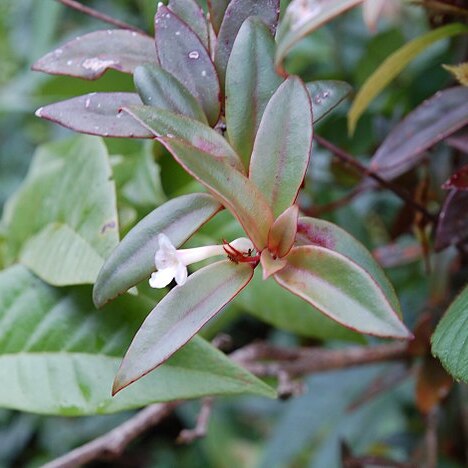Epiphytic subshrubs; stems pendent, repent, or creeping, usually ca. 30 cm long, occasionally to 2 m, 2-4 mm in diam., the nodes larger, green to reddish, the apex puberulent, glabrous below. Leaves nearly equal in a pair; blades elliptic to oblong or ovate, 1.5-5.5 cm long, 0.8-2.2 cm wide, fleshy or succulent, the apex acute, rounded to cuneate at the base, nearly entire, above dark green, rarely reddish, glabrous to minutely puberulent, below lighter green or reddish, the midvein often prominent; petiole rarely more than 1 cm long, puberulent, red extrafloral nectaries sometimes at the bases. Inflorescences axillary, 1 or 2 flowered; pedicels ca. 5 mm long, puberulent. Flowers small, uncommon, the calyx lobes free, nearly equal, the posterior lobe forced back by the corolla spur, each linear lanceolate, 2-9 mm long, green or reddish, puberulous, with reddish nectaries at the sinuses of the lobes; corolla white or cream colored, yellow on lower surface inside, rarely pink on the lobes, the tube oblique in the calyx, spurred at the base, less than 2 cm long, 1-2 mm wide at base, broader above, 5-8 mm wide at the throat, glabrous or puberulent outside, glandular inside, not grooved or ridged, limb lobes spreading, rotund, 2-6 mm wide, nearly entire; stamens included, the filaments ca. 8 mm long, adnate to the base of the corolla, glabrous or minutely glandular puberulent, the anthers rounded, ca. 1 mm long, yellow, coherent in pairs, connective angled; disc gland solitary, glabrous; ovary puberulous, style ca. 10 mm long, glabrate, the stigma stomato-morphic. Capsule tardily dehiscent, subglobose, ca. 1 cm in diam., pink to red, shiny, puberulent to glabrescent, the apex not prominent; seeds enclosed in the aril, oblong, ca. 2 mm long, longitudinally striate, reddish to brown. Chromo-somes n = 16 (Wiehler, 1975b).
More
Epiphytic subshrub, usually ca. 30 cm long, occasionally to 2 m. Stem subwoody at base, succulent above, pendent, repent, or creeping, apex puberulent, glabrous below. Leaves subequal in a pair; petiole 0.2-1.5 cm long, puberulent; blade coriaceous, often wrinkled when dry, elliptic to oblong or ovate, 1.5-8.5 x 0.6-3.9 cm, margin entire or rarely obscurely sinuate, apex acute to obtuse, base rounded to cuneate, above glabrous to minutely puberulent, below glabrous. Flowers in cymose 1-4(-12)-flowered inflorescences; epedunculate; pedicel 0.5-1.1 cm long, puberulent. Calyx green or reddish, lobes 5, free, dorsal lobe forced back by corolla spur, nearly equal, linear-lanceolate, 0.2-0.9 x 0.1 cm, margin entire, apex acute, outside and inside puberulous; corolla oblique in calyx, white, or cream colored, rarely pink on lobes, 1.5-2.8 cm long, tube funnelform, 1.2-1.8 cm long, base spurred, 0.1-0.2 cm wide, middle broader above, throat not constricted, 0.3-0.8 cm wide, outside glabrous or puberulent, inside with irregular ring of glandular hairs in throat, limb 0.6-1.5 cm wide, lobes subequal, spreading, rotund, 0.2-0.6 x 0.2-0.6 cm wide, margin nearly entire; stamens included, adnate to base of corolla tube for 0.3-0.4 cm; ovary oblong-ovoid, 0.2-0.4 x 0.1-0.2 cm wide, puberulous, style 0.8-1 cm long, glabrous, stigma stomatomorphic. Mature berry pink to red, subglobose, ca. 1 x 1 cm, apex not prominent.
A small shrub. It grows 20-30 cm tall. It can grow attached to other plants. The leaves are simple and opposite. They are oval. The flowers are tube shaped and white. The fruit are white berries. They are collected from off the ground.

